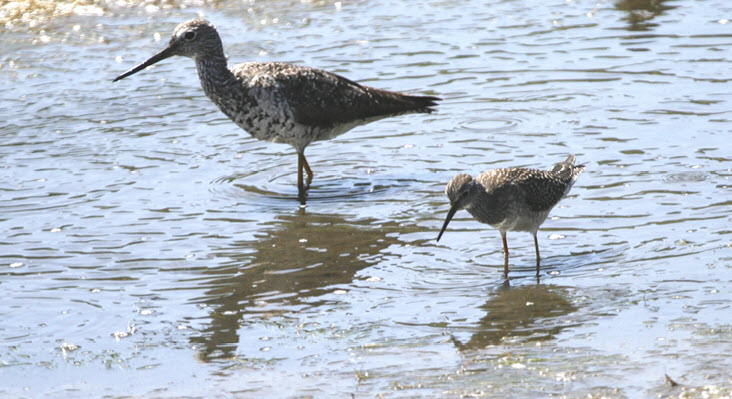Wayne R. Petersen

Wayne R. Petersen
There are groups of birds that some birders try to avoid because they don't enjoy looking at them, feel they are too difficult to identify, or don't get to see them often enough to become familiar with them. In no particular order these groups include female ducks, jaegers, shorebirds, gulls, immature hummingbirds, small flycatchers, and certain fall warblers. Even though most birders seem to have problematic or nemesis species earmarked in their field guide, with a little practice most birds or species groups are usually not as difficult as they are often perceived to be.
Shorebirds regularly appear high on the above roster of species thought to be difficult to distinguish. Even acknowledging that individual perception often translates to personal reality, many shorebirds are not too tedious to identify in the field once a few basic facts are learned. Most readers will realize that this issue's mystery species includes shorebirds of two different species, with plovers and sandpipers representing two possibilities. Plovers (Family Charadriidae) characteristically have short, stout bills; tend to have short necks and somewhat angular heads; often have banded underparts; and seldom forage by wading. By contrast, many sandpipers (Family Scolopacidae) have slim, pointed bills that are variably straight or curved; have rounder, less angular heads than plovers; and often forage by wading in shallow water. Thus, the long legs, slim pointed bills, and wading behavior of the pictured birds suggest that they are sandpipers rather than plovers.
With sandpipers in mind, another less obvious clue is that the legs appear pale, not dark. In actuality, the long legs on both species are bright lemon yellow—practically a definitive clue that the two birds are yellowlegs in the Genus Tringa. Given the dramatic size difference between the two shorebirds, it is equally reasonable to assume that the left pictured bird is a Greater Yellowlegs (Tringa melanoleuca) and the bird on the right is a Lesser Yellowlegs (Tringa flavipes). The primary object lesson in this month's column is distinguishing between these two look-alike species, much like distinguishing between Short-billed and Long-billed dowitcher, or Downy and Hairy woodpecker.
The Greater Yellowlegs is a tall, lanky, long-necked shorebird with a notably long, slim bill that often has a gentle, but noticeably upturned aspect. The smaller Lesser Yellowlegs, in contrast, has a straight bill and also has a relatively shorter neck than the Greater. More importantly, the longer bill of the Greater Yellowlegs is clearly longer than the depth of its head from front to back. The bill of the Lesser Yellowlegs is very nearly similar to the depth of the head from front to back. In addition to overall body size, this difference in the ratio between bill length and head depth is one of the most consistent features differentiating these two otherwise similar species.
The heavy dark chevrons on the sides and flanks of the larger adult Greater Yellowlegs are also different from the uniform fine speckling on the back and the somewhat uniform gray wash on the breast of the juvenile Lesser Yellowlegs. Even an adult Lesser Yellowlegs in a changing plumage comparable to that of the Greater Yellowlegs would never show the extensive bold chevrons on the sides and flanks exhibited by the Greater Yellowlegs.
In addition to the bill and plumage features described above, the behavior of the two species is different. When foraging, Greater Yellowlegs typically exhibit animated neck-pumping and often run actively through shallow water in pursuit of small fish or tiny shrimp. Greater Yellowlegs also regularly forage in small groups where all members of the flock chase small fish at the same time, thus making them readily identifiable at a great distance. These behaviors are seldom noted in the more delicate and sedate foraging of Lesser Yellowlegs, which sometimes stand in one place and gently probe the mud in front of them, unlike the more frenetic behavior of Greater Yellowlegs.
Lesser Yellowlegs are significantly earlier migrants than Greater Yellowlegs, the vanguard often appearing by July 4 with migration peaking by the third week of July. Sometimes called "winter yellowlegs," Greater Yellowlegs peak considerably later in the summer, with a few individuals regularly lingering along the Massachusetts coast until early winter. Finally, the strident three to four-note Dear, Dear, Dear call of the Greater Yellowlegs is very different from the shorter, more mellow and Short-billed Dowitcher-like Cu-Cu, Cu-Cu of the Lesser Yellowlegs.
The author photographed these Greater and Lesser yellowlegs on August 27, 2009, at Wellfleet Bay Wildlife Sanctuary, South Wellfleet, Massachusetts.
Wayne R. Petersen